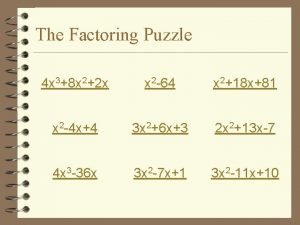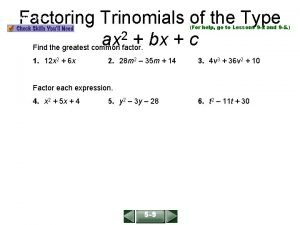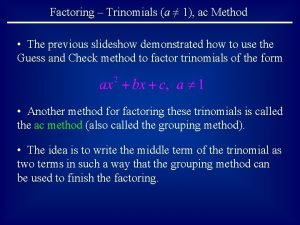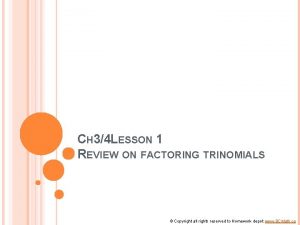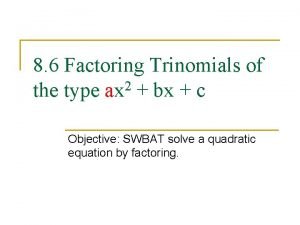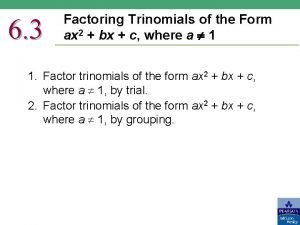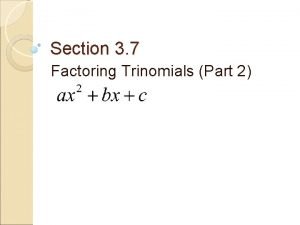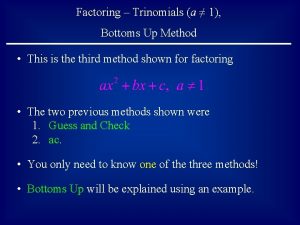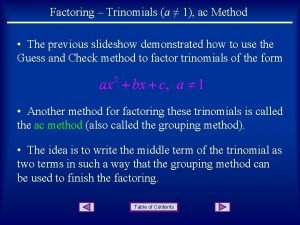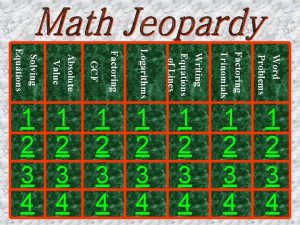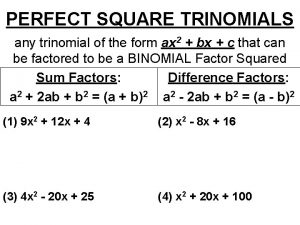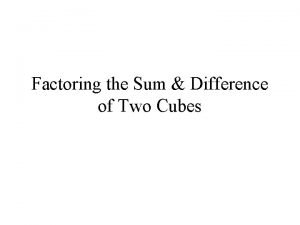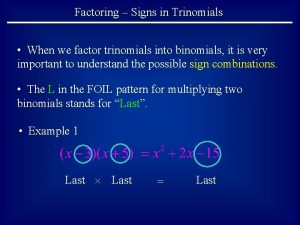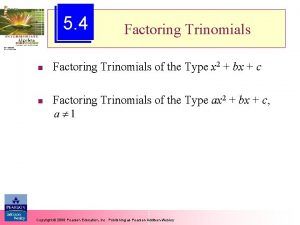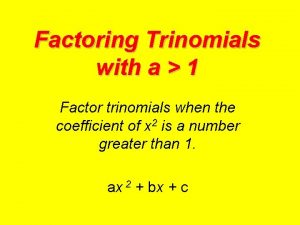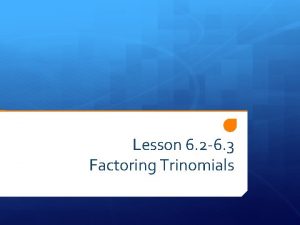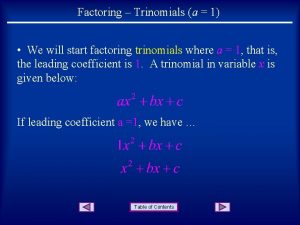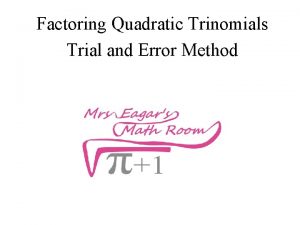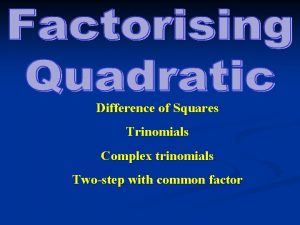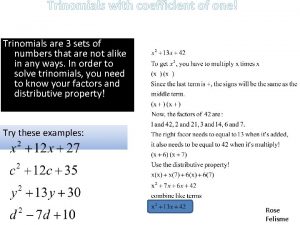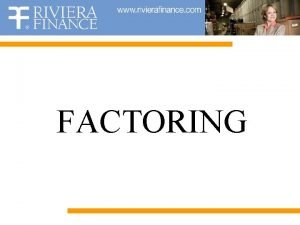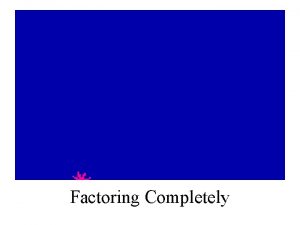Factoring Trinomials Jims Excellent Adventure The Plan Factoring

























- Slides: 25

Factoring Trinomials: Jim’s Excellent Adventure

The Plan Factoring Trinomials – 40 minutes Operations Research- 5 minutes Jim’s Fractured Career- 5 minutes

Factor Did you get?

Wolfram Alpha says it is OK.

Weird, Wonderful but Ugly. So, a road not taken. Find linear factors.

Factor into Linear Factors Did you get?

This is the “best” linear factorization! Why? Most Useful Easiest to Find

Most useful when • Solving equations • Understanding quadratic functions • Simplifying rational expressions • Finding partial fractions

Solving equations

Understanding quadratic functions

simplifying rational expressions

Finding partial fractions with traditional factoring

Finding partial fractions with ‘new” factoring

Easiest to find. First, review factoring trinomials whose leading Coefficient is I. Find two factors of ______ that add to _____. They are ____ and _____.

So, fairly easy - may need to be systematic. Now review factoring trinomials whose leading Coefficient is not I.

More review factoring trinomials whose leading Coefficient is not I. Find two factors of ______ that add to _____. They are ____ and _____.

Now the easy way. Find two factors of ______ that add to _____. They are ____ and _____.

Why it works.

Why the method works in general. Consider, Find two factors of ______ that add to _______. They are ____ and _____. References: 1. “Factoring the Trinomial ax 2+bx+1 When a>1, ” Doyne Holder, School Science and Mathematics, Oct. 1, 1958, Vol. 58, Issue 7, Pages 548 -549. 2. “A 16 -year-old girl has the math world spinning, ” Ronit Feldman, Metrotimes, July 2, 2003. http: //www. metrotimes. com/editorial/story. asp? id=5077

Where did this idea come old ( first published in 1884) textbook: A College from? An. Algebra , Revised Edition(1902), G. A. Wentworth, pages 452 -453.

Effectively stretching the Xaxis.

So, try it you will like it. And help me lead the Revolution!

Operations Research Sometimes called Industrial Engineering, Management Science, Quantitative management… Some of the tools used are statistics, optimization, probability, queuing theory, game theory, graph theory, decision analysis, simulation, and computer applications. (Wikipedia) Types of problems solved: project planning, factory layout, efficient reliable telecommunications networks, traffic flow, bus routes, computer chip layout, supply chains, robotics, freight transportation, scheduling, blending … (Wikipedia)

Classes Hatton took: Linear Programming, Microeconomics, Linear Algebra, Game Theory, Algorithmic Processes, Network Flows, Macroeconomics, Mathematical Programming, Stochastic Processes, Elementary Statistical Inferences, Reliability Models, Inventory-Production Control, Queuing Theory, Mathematical Systems Theory, Dynamic Programming, Advanced Probability, Large Scale Systems, Decision Theory, Combinatorial Analysis, Applied Probability, Modern Algebra, Advanced Stochastic Processes, and Combinatorial Optimization.

Now, Jim’s Fractured Career • Kirkwood High School St. Louis, Missouri • Rice University Houston, Texas • Stanford University, Palo Alto, California • U. S. Army, St-Louis, Missouri • Stanford University • Massachusetts, Mt Shasta, California • College of the Siskiyous, Weed, California • SOU
 Factoring jeopardy
Factoring jeopardy Factoring trinomials puzzle
Factoring trinomials puzzle Solving quadratic equations
Solving quadratic equations Factoring signs chart
Factoring signs chart Factoring ax^2+bx+c guided notes
Factoring ax^2+bx+c guided notes Factor each trinomial
Factor each trinomial Factoring ax2+bx+c when ac is positive
Factoring ax2+bx+c when ac is positive Factoring trinomials jeopardy
Factoring trinomials jeopardy Factoring cross method
Factoring cross method Factoring special cases trinomials
Factoring special cases trinomials Box method factoring
Box method factoring Reverse foil method
Reverse foil method 7-4 lesson quiz factoring polynomials
7-4 lesson quiz factoring polynomials Method of factorization
Method of factorization How to factor using cross method
How to factor using cross method Slide method factoring
Slide method factoring What is a generic rectangle
What is a generic rectangle Factoring trinomials a 1
Factoring trinomials a 1 How to do ac method
How to do ac method How to factor special cases trinomials
How to factor special cases trinomials Factor the perfect square trinomial
Factor the perfect square trinomial Factoring trinomials word problems
Factoring trinomials word problems Factoring perfect square trinomials steps
Factoring perfect square trinomials steps Sum of cubes
Sum of cubes Trinomial signs
Trinomial signs

